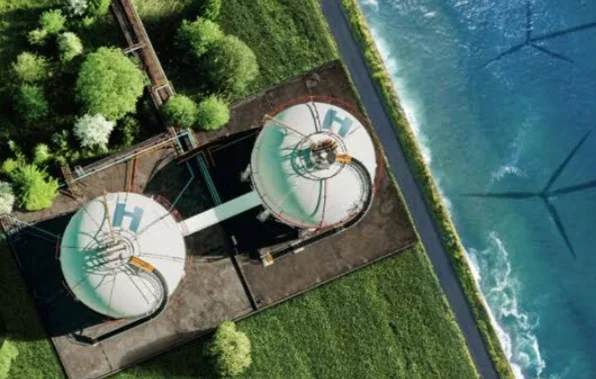Exploding Market of Green Hydrogen: A Clean Fuel Revolutionizing Energy
The world is at a crossroads in its fight against climate change. Fossil fuels, the dominant energy source for centuries, are increasingly recognized as unsustainable and harmful to the planet. In this critical juncture, a clean energy champion emerges: green hydrogen.
Produced using renewable energy sources like solar or wind power, green hydrogen is not just another fuel; it's a revolution in the making. Its potential to decarbonize various sectors and create a sustainable energy future is nothing short of explosive.
The Exploding Market of Green Hydrogen
Green hydrogen, produced using renewable energy to power the electrolysis process, is gaining significant traction as a clean and sustainable energy source. Here's a table summarizing the key factors driving its market growth:
| Factor | Explanation |
|---|---|
| Rising Energy Demand | Growing global population and economic development are increasing energy demand, creating a need for cleaner alternatives. |
| Climate Change Concerns | The urgent need to reduce greenhouse gas emissions is driving the adoption of green hydrogen as a decarbonization solution. |
| Government Support | Many governments are providing incentives, policies, and investments to promote green hydrogen development. |
| Technological Advancements | Improvements in electrolysis technology and renewable energy sources are making green hydrogen production more efficient and cost-effective. |
| Industrial Applications | Green hydrogen is increasingly being used in various industries, including steelmaking, ammonia production, and transportation. |
| Energy Storage | Green hydrogen can be used for energy storage, providing flexibility and grid stability. |
| International Cooperation | Global partnerships and collaborations are accelerating the development and deployment of green hydrogen projects. |
A Market on Fire:
The green hydrogen market is experiencing unprecedented growth, projected to reach a staggering $7.3 billion by 2027. That's a compound annual growth rate (CAGR) of 61.0%, a testament to the immense potential this clean fuel holds.
This rapid expansion is fueled by several factors:
- Rising climate change awareness: As the impacts of climate change become ever more apparent, the need for clean energy solutions is gaining urgency. Green hydrogen, with its zero-carbon emissions, offers a compelling alternative to fossil fuels.
- Falling renewable energy costs: The cost of solar and wind power has plummeted in recent years, making them increasingly competitive with traditional energy sources. This directly translates to cheaper green hydrogen production.
- Supportive government policies: Governments worldwide are recognizing the potential of green hydrogen and implementing policies to support its development. This includes subsidies, tax breaks, and funding for research and development.
Beyond Hype: Where the Boom is Happening:
The green hydrogen revolution is not just a theoretical concept; it's already transforming specific sectors:
-
Transportation: Heavy-duty trucks, ships, and even airplanes are traditionally reliant on fossil fuels, making them major contributors to greenhouse gas emissions. Green hydrogen offers a clean alternative, with fuel cell vehicles and ships emerging as viable options. Imagine majestic cargo ships gliding across the oceans powered by clean hydrogen, leaving no harmful emissions in their wake.
-
Industry: Industrial processes like steel and chemical production often rely on fossil fuels, making them another significant source of emissions. Green hydrogen can be used to create clean alternatives to these fossil fuel-based processes, paving the way for a more sustainable industrial future.
Challenges and the Road Ahead:
Despite its immense potential, green hydrogen still faces hurdles:
- High production cost: Currently, green hydrogen is more expensive to produce than conventional fuels. However, rapid advancements in electrolysis technology and falling renewable energy prices are expected to bring down costs significantly in the coming years.
- Infrastructure development: Building the necessary infrastructure for storing, transporting, and utilizing green hydrogen is a significant challenge. This includes developing efficient pipelines, storage facilities, and refueling stations.
Overcoming these challenges requires continued investment in research and development, strong government support, and international collaboration. Initiatives like the Hydrogen Mission Innovation (HMI) are fostering global cooperation to accelerate the development and deployment of green hydrogen technologies.
Green Hydrogen Market Explosion: Statistics and Growth Projections
The green hydrogen market is experiencing a meteoric rise, fueled by increasing climate change awareness, falling renewable energy costs, and supportive government policies. Here's a glimpse into this exciting trend through some key statistics and a handy table:
Market Growth:
- Projected market size by 2027: $7.3 billion (a staggering 61.0% CAGR)
- Key drivers: Rising climate concerns, falling renewable energy costs, supportive government policies
- Sectors targeted: Transportation (heavy-duty trucks, ships, aviation), industry (steel, chemicals)
Cost Reduction:
- Current challenge: High production cost compared to fossil fuels
- Positive outlook: Rapid advancements in electrolysis technology and falling renewable energy prices
- Predicted cost reduction by 2030: 50%, making green hydrogen increasingly competitive
Global Landscape:
- Regions to watch: Middle East, North Africa, Australia (rich in renewable resources)
- International collaboration: Hydrogen Mission Innovation (HMI) fostering research and development efforts
Table: Green Hydrogen Market Statistics
| Statistic | Data |
|---|---|
| Market size (2022) | $1.4 billion |
| Projected market size (2027) | $7.3 billion |
| CAGR (2022-2027) | 61.0% |
| Key drivers | Climate change awareness, falling renewable energy costs, supportive government policies |
| Targeted sectors | Transportation, industry |
| Current production cost challenge | High compared to fossil fuels |
| Predicted cost reduction by 2030 | 50% |
| Regions with high potential | Middle East, North Africa, Australia |
| International collaboration initiative | Hydrogen Mission Innovation (HMI) |
The Future is Green:
The future of energy is undoubtedly clean, and green hydrogen is poised to play a starring role in this transformation. Its ability to decarbonize various sectors, coupled with its rapid technological advancements and increasing market momentum, makes it a game-changer in the fight against climate change.
As the green hydrogen market explodes, expect to see:
- A surge in green hydrogen production projects worldwide.
- Innovation in storage, transportation, and utilization technologies.
- The gradual decline of green hydrogen production costs, making it increasingly competitive with fossil fuels.
- The emergence of green hydrogen as a mainstream energy source, powering homes, industries, and transportation.
The clean energy revolution is here, and green hydrogen is leading the charge. Buckle up, because the future looks bright and sustainable.



